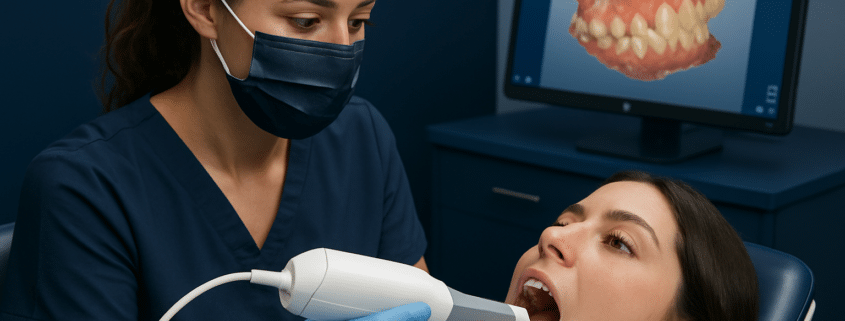Top 5 Ways Intraoral Scanners Are Changing Dental Appointments
Gone are the days of bite trays, goopy impressions, and 15 minutes of jaw clenching while your dentist makes a mold of your teeth. Welcome to the era of intraoral scanners—the dental technology that’s replacing mess with precision, speed, and comfort.
The rise in intraoral scanner uses is one of the biggest shifts in modern dentistry. Whether you’re getting Invisalign, crowns, or just a routine exam, this tiny handheld device is rewriting the rules of your dental visit. Here’s how.
TLDR – Quick Guide
- Intraoral scanners are replacing traditional impressions with digital scans—faster, cleaner, and more accurate.
- They’re used in everything from cosmetic planning to oral cancer detection.
- Patients benefit from shorter appointments and improved outcomes.
- Dental clinics like Valery Sweeny, DDS are using this tech to enhance both diagnostics and patient experience.
Detailed Breakdown: Top 5 Intraoral Scanner Uses
1. No More Gag-Inducing Impressions
Let’s be honest: traditional dental impressions are awful. Intraoral scanners use high-resolution cameras to create a 3D digital model of your teeth—no trays, no mess, no gagging.
- Use Case: Crowns, bridges, implants, and retainers
- Benefit: Increased comfort and faster turnaround time
- Game-Changer Factor: High—especially for patients with strong gag reflexes or dental anxiety
2. Faster and More Accurate Invisalign Planning
Intraoral scanners are now the industry standard for clear aligner treatment. The accuracy of digital scans leads to better-fitting trays and fewer mid-treatment adjustments.
- Use Case: Invisalign and other orthodontic treatment
- Benefit: Streamlined planning and fewer refinements
- Game-Changer Factor: Huge—especially for teens and busy professionals
3. Real-Time Patient Education
Many scanners provide a visual on-screen 3D rendering of your mouth, which dentists can rotate and zoom into. This allows for crystal-clear explanations of issues like cavities, wear, and gum recession.
- Use Case: Diagnostic exams and treatment plans
- Benefit: Patients actually understand their oral health
- Game-Changer Factor: Moderate—but excellent for trust and transparency
4. Improved Crown and Veneer Fittings
Thanks to precise scanning, restorations like crowns, inlays, onlays, and veneers fit better, look more natural, and require fewer adjustments.
- Use Case: Cosmetic and restorative dentistry
- Benefit: Fewer follow-up appointments and better long-term results
- Game-Changer Factor: High—precision equals durability
5. Early Detection of Oral Health Issues
Advanced intraoral scanners can capture fine details that help detect decay, wear, or lesions that might go unnoticed in a traditional visual exam.
- Use Case: Preventive care and monitoring
- Benefit: Early intervention = less invasive treatment later
- Game-Changer Factor: Essential—especially for high-risk patients
Why Dentists Are Making the Switch
Dental offices across Los Angeles, including Valery Sweeny, DDS, are embracing intraoral scanning technology because it’s better for everyone:
- Clinicians: More accurate records and streamlined workflows
- Labs: Faster turnaround and better-fitting appliances
- Patients: Shorter appointments, clearer communication, and no post-impression trauma
It’s not just a shiny gadget—it’s a serious upgrade in patient care.
Key Takeaways
- Intraoral scanner uses are transforming modern dentistry from diagnostics to treatment planning.
- They eliminate discomfort and inaccuracy from traditional impressions.
- Scanners streamline orthodontic treatments like Invisalign, and improve the fit of restorations.
- Patients benefit from real-time visuals and early issue detection.
- Forward-thinking practices in LA, like Valery Sweeny, DDS, are leading the charge in implementing this tech for a better dental experience.
FAQs
Are intraoral scans as accurate as traditional impressions?
They’re actually more accurate. Digital scanning minimizes human error and captures precise 3D data.
Does the scan hurt or cause discomfort?
Not at all. The scanner is a small wand that glides comfortably around your mouth—no trays or putty.
How long does an intraoral scan take?
Most full-mouth scans are completed in under five minutes.
Can intraoral scanners detect cavities?
They can reveal early signs of decay, especially when paired with diagnostic tools like fluorescence or transillumination.
Is this technology available at all dental offices?
Not yet, but more practices are adopting it. Clinics like Valery Sweeny, DDS already use intraoral scanners for a wide range of services.




Leave a Reply
Want to join the discussion?Feel free to contribute!